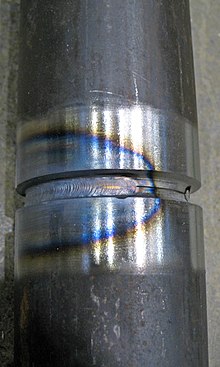Most often, the major metric used for judging the quality of a weld is its strength and the strength of the material around it. Many distinct factors influence this, including the welding method, the amount and concentration of energy input, the base material, the filler material, the flux material, the design of the joint, and the interactions between all these factors. To test the quality of a weld, either destructive ornondestructive testing methods are commonly used to verify that welds are defect-free, have acceptable levels of residual stresses and distortion, and have acceptable heat-affected zone (HAZ) properties. Welding codes and specifications exist to guide welders in proper welding technique and in how to judge the quality of welds.
[edit]Heat-affected zone
The effects of welding on the material surrounding the weld can be detrimental—depending on the materials used and the heat input of the welding process used, the HAZ can be of varying size and strength. The thermal diffusivity of the base material plays a large role—if the diffusivity is high, the material cooling rate is high and the HAZ is relatively small. Conversely, a low diffusivity leads to slower cooling and a larger HAZ. The amount of heat injected by the welding process plays an important role as well, as processes like oxyacetylene welding have an unconcentrated heat input and increase the size of the HAZ. Processes like laser beam welding give a highly concentrated, limited amount of heat, resulting in a small HAZ. Arc welding falls between these two extremes, with the individual processes varying somewhat in heat input.[31][32] To calculate the heat input for arc welding procedures, the following formula can be used:
where Q = heat input (kJ/mm), V = voltage (V), I = current (A), and S = welding speed (mm/min). The efficiency is dependent on the welding process used, with shielded metal arc welding having a value of 0.75, gas metal arc welding and submerged arc welding, 0.9, and gas tungsten arc welding, 0.8.[33]
[edit]Defects
There are many types of defects that can occur depending on the material and welding process. Types of defects include cracks, distortion, gas inclusions (porosity), non-metallic inclusions, lack of fusion, incomplete penetration, lamellar tearing, and undercutting.
[edit]Weldability
The quality of a weld is also dependent on the combination of materials used for the base material and the filler material. Not all metals are suitable for welding, and not all filler metals work well with acceptable base materials.
[edit]Unusual conditions
While many welding applications are done in controlled environments such as factories and repair shops, some welding processes are commonly used in a wide variety of conditions, such as open air, underwater, and vacuums (such as space). In open-air applications, such as construction and outdoors repair, shielded metal arc welding is the most common process. Processes that employ inert gases to protect the weld cannot be readily used in such situations, because unpredictable atmospheric movements can result in a faulty weld. Shielded metal arc welding is also often used in underwater welding in the construction and repair of ships, offshore platforms, and pipelines, but others, such as flux cored arc welding and gas tungsten arc welding, are also common. Welding in space is also possible—it was first attempted in 1969 by Russian cosmonauts, when they performed experiments to test shielded metal arc welding, plasma arc welding, and electron beam welding in a depressurized environment. Further testing of these methods was done in the following decades, and today researchers continue to develop methods for using other welding processes in space, such as laser beam welding, resistance welding, and friction welding. Advances in these areas may be useful for future endeavours similar to the construction of the International Space Station, which could rely on welding for joining in space the parts that were manufactured on Earth.[34]



No comments:
Post a Comment